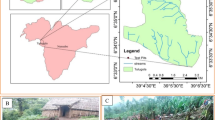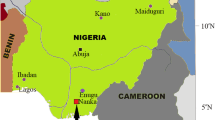Abstract
The July 12, 2016 Tombinoutek landslide along state highway between Imphal and Jouzangtek village, Manipur, India affected the road section for a stretch of ∼475 m. The research aimed at finding the combined effects of topography, lithology and structural attributes of the landslide. Detailed geodetic survey was carried out using drone supported by ground control points obtained by total station survey. Base map with 5 m contour intervals, slope and aspect maps prepared; critical slope is between 45° to 60°. Geological studies have shown occurrence of intercalated sandstones and dissected shale, disturbed by five prominent joint sets which play an active role in the initiation of the landslide through plane and wedge failures. Geotechnical analyses of sandstones indicated strong compressive strength ranging between 80 and 97 Mpa, and tensile strength of sandstones and shales between 17 and 20 Mpa and 2.62 and 3.27 Mpa respectively. Soil analyses showed plasticity index (IP, percentage) of 10.66, and liquid limit (WL%) of 32.5. Average soil porosity is 80%. Liquidity index of -1.208 indicates relatively stable condition under dry condition. Plasticity index of 10.66 lies in the CL field, close to the boundary between low plasticity and medium plasticity. Sandstones show fair rock RMR with class IIb stable SMR, and shales show poor rock RMR with class IIIb partially stable SMR.
Similar content being viewed by others
References
Abraham, P.B. and Shaji, E. (2013) Landslide Hazard Zonation in and around Thodupuzha—Idukki—Munnar Road, Idukki District, Kerala: A Geospatial Approach. Jour. Geol. Soc. India, v.82, pp.649–656.
Achour, Y., Boumezbeur, A., Hadji, R., Chouabbi, A., Cavaleiro, V. and Bendaoud, E. A. (2017) Landslide susceptibility mapping using analytic hierarchy process and information value methods along a highway road section in Constantine, Algeria. Arabian Jour. Geosci., v.10, 194p.
Althuwaynee, O.F., Pradhan, B. and Lee, S. (2016) A novel integrated model for assessing landslide susceptibility mapping using CHAID and AHP pair-wise comparison. Internal Jour. Remote Sensing, v.37(5), pp. 1190–1209, doi:https://doi.org/10.1080/01431161.2016.1148282.
Andriani, G.F., Diprizio, G. and Pellegrini, V. (2015) Landslide susceptibility of the La Catola Torrent catchment area (Daunia Apennines, southern Italy): A new complex multi-step approach. In: Engineering Geology for Society and Territory, v.5, pp.387–392. Cham: Springer.
Alexakis, D. D., Agapiou, A., Tzouvaras, M., Themistocleous, K., Neocleous, K., Michaelides, S. and Hadjimitsis, D. G. (2013) Integrated use of GIS and remote sensing for monitoring landslides in transportation pavements: The case study of Paphos area in Cyprus. Natural Hazards, v.72, pp.119–141.
Anbalagan, R. (1992) Landslide hazard evaluation and zonation mapping in mountainous terrain. Engg. Geol., v.32(4), pp.269–277.
ASTM D2487-06. Standard practice for classification of soils for engineering purposes (unified soil classification system).
ASTM D2488-09a. Standard practice for description and identification of soils (visual-manual procedure).
Casagrande, A. (1948) Classification and identification of soils. Transactions, ASCE, v.113, pp.901–930.
Bieniawski, Z. T. (1989) Engineering rock mass classifications: a complete manual for engineers and geologists in mining, civil, and petroleum engineering: New York, Wiley, xii, 251p.
Broch, E. and Franklin, J. A. (1972) The point-load strength test. Internat. Jour. Rock Mech. Min. Sci., v.9, pp.669–697.
Brown, E.T. (Ed.) (1981) Rock characterisation testing and monitoring, ISRM suggested methods. Pergamon Press.
Chen, W., Xie, X., Peng, J., Shahabi, H., Hong, H., Tien Bui, D., Duan, Z., Li, S. and Zhu, A.X. (2018) GIS-based landslide susceptibility evaluation using a novel hybrid integration approach of bivariate statistical based random forest method. Catena, v.164, pp.135–149. https://www.gsi.gov.in/webcenter/portal/OCBIS/pageQuickLinks/pageLandslideIncidents?
Kornejady, A., Ownegh, M. and Bahremand, A. (2017) Landslide susceptibility assessment using maximum entropy model with two different data sampling methods. Catena, v.152, pp.144–162.
Kumar, A. and Sanoujam, M. (2007) Landslide Studies along the National Highway (NH-39) in Manipur. Natural Hazards, v.40(3), pp.603–614.
Kumar, S. (2020) Slope analysis and landslide evaluation: A case study of Shimla district. Jour. Critical Rev., v.7(12), pp.2119–2126. ISSN-2394–5125.
Lourembam, M.C. and Oinam, B. (2021) Impact study for landslide contributing factors using a multi-criterion approach for landslide susceptibility. Arabian Jour. Geosci., v.14, 1873.
Mathur, U., Kumar, N., Pandey, T.N. and Choudhary, A. (2017) Study of Index Properties of the Soil. Internat. Jour. Adv. Res. and Innovative Ideas in Education, v.3(3).
Moirangthem, O. and Singh, R.A.K. (2018) Landslide hazard zonation in and around Litan village along NH-202, Ukhrul district, Manipur, India. NGJI, A. International Refereed Journal, v.64(1–2), pp.93–103. (NGSI-BHU, ISSN: 0027-9374/208/1647).
Moirangthem, O., Singh, R.A.K. and Goel, O.P. (2019) A study of landslides along part of a national highway in Manipur, India. Internat. Jour. Econ. Environ. Geol., v.1(1), pp.48–50.
Mukhlisin, M., Taha, M.R. and Kosugi, K. (2009) Numerical analysis of effective soil porosity and soil thickness effects on slope stability at a hillslope of weathered granitic soil formation. Geosci. Jour., v.12, pp.401–410.
Nourani, V., Pradhan, B., Ghaffari, H. and Sharifi, S. S. (2014) Landslide susceptibility mapping at Zonouz Plain, Iran using genetic programming and comparison with frequency ratio, logistic regression and artificial neural network models. Natural Hazards, v.71, pp.523–547.
Pachauri, A. K. and Pant, M. (1992) Landslide hazard mapping based on geological attributes. Engg. Geol., v.32, pp.81–100.
Ramasamy, S.M., Gunasekaran, S., Saravanavel, J., Melwyn Joshua, R., Rajaperumal, R., Kathiravan, Palanivel, K. and Muthukumar, M. (2020) Geomorphology and Landslide Proneness of Kerala, India: A Geospatial study. Landslides, doi: https://doi.org/10.1007/s10346-020-01562-9.
Sarkar, S. and Kanungo, D. P. (2004) An integrated approach for landslide susceptibility mapping using remote sensing and GIS. Photogram. Engg. Remote Sensing, v.70(5), pp.617–625.
Soibam, I. (1998) On the Geology of Manipur. In: Souvenir, IX Manipur Science Congress (March 25–27), pp.12–19.
Singh, C.D. and Singh, J. (2013) Landslides Caused due to Ignorance — Case Studies from Northeast India. Jour. Geol. Soc. India, v.82, pp.649–656.
Tsangaratos, P. and Benardos, A. (2014) Estimating landslide susceptibility through an artificial neural network classifier. Natural Hazards, v.74, pp.1489–1516.
Vakhshoori, V. and Zare, M. (2016) Landslide susceptibility mapping by comparing weight of evidence, fuzzy logic, and frequency ratio methods. Geomatics, Natural Hazards and Risk, v.7(5), pp.1731–1752.
Acknowledgements
I am very much thankful to Dr. Bhoop Singh, Head (Retd.) NRDMS, and Dr. Ashok Kumar Singh, Principal Scientific Officer (Retd.) for the landslide project No. NRDMS/02/46/016(G), 16/03/2018. My sincere thanks also go to Prof. Arun Kumar co-ordinator of the ‘Networking Programme on Landslide Hazard Mitigation for North East states, India’ for his unending co-operation in the completion of the project successfully. The support of Prof. Soibam Ibotombi for the permission to use the geotechnical laboratory in Department of Earth Sciences, Manipur University is highly appreciated.
Author information
Authors and Affiliations
Corresponding author
Rights and permissions
About this article
Cite this article
Rajkumar, H.S., Heisnam, S.S., Kongbrailatpam, J.S. et al. Investigation of Tombinoutek Landslide, Old Cachhar Road, Manipur, India. J Geol Soc India 99, 156–164 (2023). https://doi.org/10.1007/s12594-023-2281-5
Received:
Accepted:
Published:
Issue Date:
DOI: https://doi.org/10.1007/s12594-023-2281-5




